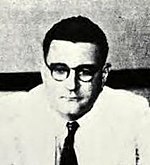Carlos E. Chardón
| Carlos E. Chardón Palacios | |
|---|---|

"Father of Mycology in Puerto Rico"
|
|
| Native name | Carlos Eugenio Chardón Palacios |
| Born | September 28, 1897 Ponce, Puerto Rico |
| Died |
7 March 1965 (aged 67) San Juan, Puerto Rico |
| Nationality | Puerto Rican |
| Fields | Phytopathology and Mycology |
| Institutions |
Agricultural Experimental Station (1922) |
| Patrons | Bolivia, Colombia, Dominican Republic, Iran, Puerto Rico, and Venezuela |
| Alma mater | Cornell University |
| Doctoral advisor | Herbert H. Whetzel |
| Known for | Discovered vector of the sugar cane Mosaic virus |
| Children | Carlos A. Chardón López |
| Notes | |
|
Carlos Fernando Chardón (brother)
|
|
Agricultural Experimental Station (1922)
PR Dept of Agriculture (1920s)
UPR (1931-1935)
PR Reconstruction Administration (1930s)
PR Lands Authority (1940)
Carlos Eugenio Chardón Palacios, D.Sc., D.Litt, (September 28, 1897 – March 7, 1965) was the first Puerto Rican mycologist, a high-ranking official in government on agriculture during the 1920s, the first Puerto Rican appointed as Chancellor of the University of Puerto Rico (1931-1935), and the head of the Puerto Rico Reconstruction Administration in the mid-to late 1930s during the Great Depression. He was also known as "the Father of Mycology in Puerto Rico". He discovered that the aphid "Aphis maidis" was the vector of the sugar cane Mosaic virus. Mosaic viruses are plant viruses.
In the 1920s, he was appointed as Commissioner of Agriculture and Labor. In that position, he traveled in Central and South America, aiding agricultural programs in Colombia, Venezuela, Bolivia and Dominican Republic. After serving as a university administrator and head of a major agency, he returned to his academic work in the fields of land use and agriculture in 1940 and later. He published several books on his studies in Puerto Rico and Latin America.
Chardón (birth name: Carlos Eugenio Chardón Palacios) was born in Ponce, Puerto Rico, to Carlos Felix Chardón and Isabel Palacios Pelletier. His great-grandfather, Juan Bautista Chardón, a Catholic native of Champagne, France, immigrated to Puerto Rico from Louisiana in 1816, encouraged by the Royal Decree of Graces issued by the Spanish Crown, which was trying to attract new settlers to the island
...
Wikipedia
